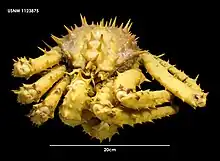Neolithodes diomedeae
Neolithodes diomedeae is a species of king crab which is found in the eastern Pacific Ocean, the southwestern Atlantic Ocean, and the Bellingshausen and Scotia Seas in the Southern Ocean.[2][3][4][5][6] They occur from 200 to 2,454 m (655 to 8,050 ft).[7]
| Neolithodes diomedeae | |
|---|---|
 | |
| Scientific classification | |
| Domain: | Eukaryota |
| Kingdom: | Animalia |
| Phylum: | Arthropoda |
| Class: | Malacostraca |
| Order: | Decapoda |
| Suborder: | Pleocyemata |
| Infraorder: | Anomura |
| Family: | Lithodidae |
| Genus: | Neolithodes |
| Species: | N. diomedeae |
| Binomial name | |
| Neolithodes diomedeae Benedict, 1894[1] | |
Diet
Neolithodes diomedeae are opportunistic, necrophagous scavengers.[3][8] In the Gulf of California's abyssal plain, they live around hydrothermal vents and feed on organic material which falls from the pelagic zone.[3]
Behavior
In deep-sea sedimentary habitats, young N. diomedeae have been found to have a symbiotic relationship with sea cucumbers, frequently situating themselves on or underneath members of the genus Scotoplanes. This relationship is hypothesized to be related to elevated food availability and shelter from predation.[9] They have also shown an affinity for situating themselves on corals, especially as juveniles.[10]
References
- Benedict, James Everard (1894). "Scientific Results of Explorations by the U.S. Fish Commission Steamer Albatross". Proceedings of the United States National Museum. XVII: 479–488. ISSN 0096-3801.
- Ahyong, Shane T. (2010). The Marine Fauna of New Zealand: King Crabs of New Zealand, Australia, and the Ross Sea (Crustacea: Decapoda: Lithodidae) (PDF). NIWA Diversity Memoirs. Vol. 123. National Institute of Water and Atmospheric Research. p. 73. ISBN 978-0478232851. LCCN 2010497356. Archived (PDF) from the original on 15 February 2020.
- Escobar-Briones, Elva; Morales, Pedro; Cienfuegos, Edith; González, Manuel (December 2002). "Carbon sources and trophic position of two abyssal species of Anomura, Munidopsis alvisca (Galatheidae) and Neolithodes diomedeae (Lithodidae)" (PDF). In Hendrickx, Michel Edmond (ed.). Contributions to the Study of East Pacific Crustaceans. Vol. 1. National Autonomous University of Mexico. pp. 37–432. ISBN 978-9703201686 – via the Natural History Museum of Los Angeles County.
- Griffiths, Huw J.; Whittle, Rowan J.; Roberts, Stephen J.; Belchier, Mark; Linse, Katrin (July 2013). Archambault, Philippe (ed.). "Antarctic Crabs: Invasion or Endurance?". PLoS One. 8 (7): e66981. Bibcode:2013PLoSO...866981G. doi:10.1371/journal.pone.0066981. PMC 3700924. PMID 23843974.
- García Raso, J. E.; Manjón-Cabeza, M. E.; Ramos, A.; Olaso, I. (23 March 2005). "New record of Lithodidae (Crustacea Decapoda, Anomura) from the Antarctic (Bellingshausen Sea)" (PDF). Polar Biology. 28 (8): 642–646. doi:10.1007/s00300-005-0722-9. S2CID 2955102. Archived (PDF) from the original on 20 May 2020 – via the University of Málaga.
- Anosov, Sergey E.; Spiridonov, Vassily A.; Neretina, Tatiana V.; Uryupova, Ekaterina F.; Schepetov, Dimitry (27 September 2014). "King crabs of the western Atlantic sector of Antarctic and adjacent areas: new records, molecular barcode data and distribution (Crustacea: Decapoda: Lithodidae)". Polar Biology. 38 (2): 231–249. doi:10.1007/s00300-014-1581-z. S2CID 15618617. Retrieved 21 May 2020 – via ResearchGate.
- Lovrich, Gustavo A.; Tapella, Federico (2014). "Southern King Crabs". In Stevens, Bradley G. (ed.). King Crabs of the World: Biology and Fisheries Management. CRC Press. p. 450. doi:10.1201/b16664. ISBN 978-0429063176. LCCN 2013036692.
- Yau, Cynthia; Collins, Martin A.; Bagley, Phil M.; Everson, Inigo; Priede, Imants G. (2002). "Scavenging by megabenthos and demersal fish on the South Georgia slope". Antarctic Science. 14 (1): 16–24. Bibcode:2002AntSc..14...16Y. doi:10.1017/S0954102002000536. S2CID 130271970. Archived (PDF) from the original on 21 May 2020. Retrieved 21 May 2020 – via ResearchGate.
- Barry, James P.; Taylor, Josi R.; Kuhnz, Linda A.; De Vogelaere, Andrew P. (2017). "Symbiosis between the holothurian Scotoplanes sp. A and the lithodid crab Neolithodes diomedeae on a featureless bathyal sediment plain". Marine Ecology. 38 (2): e12396. Bibcode:2017MarEc..38E2396B. doi:10.1111/maec.12396.
- Girard, Fanny; Litvin, Steven Y.; Sherman, Alana; McGill, Paul; Lovera, Christopher; DeVogelaere, Andrew; Burton, Erica; Barry, James P. (June 2023). "Epibenthic faunal community dynamics and seasonal species turnover in a deep-sea coral ecosystem". Deep Sea Research Part I: Oceanographic Research Papers. 196: 104048. Bibcode:2023DSRI..19604048G. doi:10.1016/j.dsr.2023.104048.
External links
 Media related to Neolithodes diomedeae at Wikimedia Commons
Media related to Neolithodes diomedeae at Wikimedia Commons Data related to Neolithodes diomedeae at Wikispecies
Data related to Neolithodes diomedeae at Wikispecies